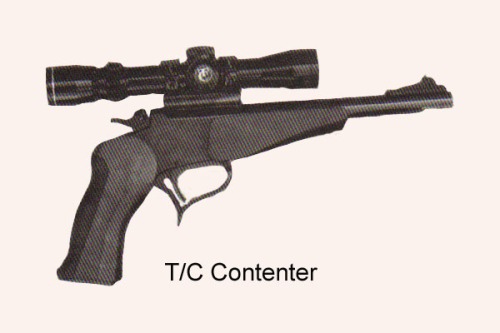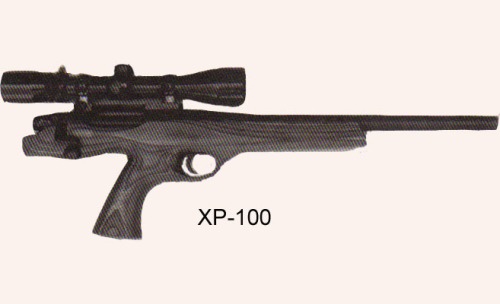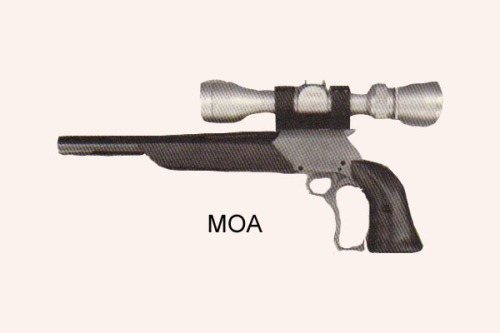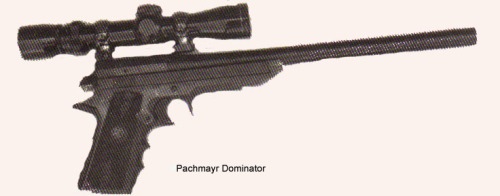
Unfortunately for us taxpayers, there’s no news about tycoons and politicians downsizing their ambition, but a couple of years ago, the shooters and handgun hunters who run Freedom Arms donned their downsize thinking caps, and the end result may be the best 357 Mag. revolver ever. It’s designated the Model 97, and while it’s downsized to about 90 percent of the big Freedom Arms revolvers, the cylinder on the new gun holds six rounds instead of five.

Freedom fanatics need not panic; downsizing the gun’s dimensions has not affected quality. Existing manufacturing techniques and processes like line-boring, close tolerance fit, and meticulous hand-finishing are all being applied to the new gun.
Barrel-cylinder gaps are still set .003″ and trigger pulls at 3 lbs. Like its big brothers, sight options on the Model 97 still include the fixed sight (notch in topstrap and silver front blade), and the same style adjustable sights with black front ramp and blued rear sight scaled down to fit the smaller channel cut in the topstrap. The adjustable sights on the Model 97 are like those on the large Field Grade guns rather than the Premier Grades (i.e., a clamping screw must be loosened to adjust for windage).
Little Big Gun
Barrel lengths are either 5 ½” or 7 ½”, both with either fixed or adjustable sights. The rear notch on the fixed sight version is square rather than a “U” or a “V.” The stainless front sight is also square, but not as wide as the black blade on the adjustable sighted gun.
Interestingly, while the fixed sights are more difficult to see (at least for older eyes), and less precise than the adjustable sights, the stainless front blade is more visible in dim light conditions. Sight picture with the adjustable sighted Model 97 was indistinguishable from that of the big frame guns.
Ergonomics, balance and handling characteristics are superb on the smaller gun. It rivals the original Colts (and imported clones), while offering a slightly longer grip for proper positioning of the little finger of the shooting hand as opposed to having the pinkie pushed under the gun butt.
At the same time, the Model 97 doesn’t have the overly large “club” feel of a full size Bisley grip. It’s the right-sized grip to handle the recoil of full .357 Mag. ammo, or even something heavier like a .41 Mag. or whatever caliber Freedom next offers in this gun.
In short, the grip is “right” for the gun because it will allow the shooter to handle any level of recoil suitable for this size revolver. This may not be of much interest to cowboy shooters who will hold velocities to something under 800 fps, but it’s important to handgun hunters, and in the adjustable sighted version, this is one dandy hunting gun.
Semi-Serious Informal Shooting
I acquired an adjustable sighted gun with a 5’/2″ barrel because I envisioned spending some relaxed “trail time.” along with doing a bit of semi-serious hunting, and 5″ to 6″ barrels are my preference for these kinds of endeavors. As long as I can see iron sights, (and my vision is still OK in daylight hours), unscoped belt guns are my number one passion in handgun hunting.
Despite preferences, the little gun was equipped with a scope for sighting in and a trip to the YO Ranch involving both a hunt and a handgun hunting-style match. The petite Model 97 was fitted with the smallest handgun scope on the market, Leupold’s 2x EER pistol scope, and a modified T’SOB scope base from SSK. SSK will be making scope bases properly sized for the new gun soon.
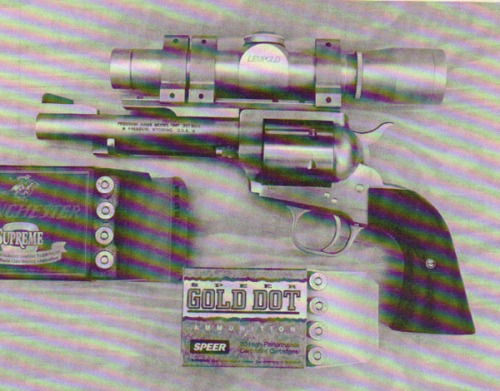
The 2x was entirely suitable for my purposes, and anything bigger tends to overwhelm the gun, both aesthetically and in terms of handling characteristics. However, the balance of the smaller frame gun with the 7.5″ barrel is also excellent, and the longer barrel offers a couple of advantages to the handgun hunter. You will eke out a bit more velocity from the extra 2″ of barrel, and the gun’s longer overall dimension encourages, or at least allows, the use of a larger scope, perhaps a variable power. Your choice.
Too Good For His Own Good
Prior to the hunt I put a few hundred rounds of cowboy ammo through the gun. Cowboy action shooters like smoke; so factory ammo for cowboy shooters produces smoke along with lots of cruddy residue. This is not a problem for the gun functionally, but over time, it makes the gun filthy. Not dirty, filthy!
This is the one occasion where the tight tolerances and stainless steel of Freedom Arms’ guns may not be fully appreciated. To avoid problems, just clean and lubricate periodically, especially the cylinder pin, to insure the cylinder rotates freely. Also, clean the barrel after shooting lots of lead cowboy ammo before you start popping jacketed bullets down range
I failed to do so before sighting in and the first 20 or so rounds of factory jacketed ammo produced depressingly large groups at the 50 yard range. When the barrel had finally been scraped clean, things settled in, and the little gun started turning in 1″ to 2″ groups with the 2x scope, depending on what ammo was being consumed.
After putting nine different factory loads through the gun over sandbags. I had what I wanted: a variety of suitable factory loads, up through a 180 grain deep-penetrating bullet, for hunting small to medium-large game.
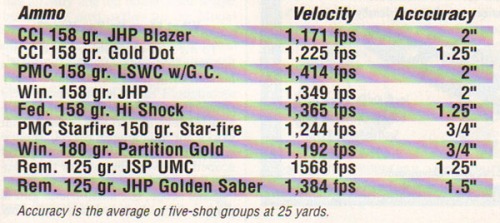
The accuracy of Freedom Arms revolvers is not surprising, nor is it a mystery. The precise alignment of each chamber with the barrel results from the Wyoming factory’s line-boring manufacturing technique, allowing barrel forcing cones of only three degrees to be used on Freedom revolvers.
Typical forcing cones on mass-produced revolvers are much higher to compensate for misalignment of chambers and barrels that result from looser manufacturing tolerances. Use of a higher power scope might have produced even better accuracy, but as stated, my search was for a compact hunting handgun.
Whacking Everything In Sight
The trip to the YO Ranch could hardly have been more successful. With the Leupold scope in place and using Winchester’s new 180 gr. Partition Gold ammunition, I collected a Sika buck at about 70 yards and went through the handgun hunting match successfully, whacking almost all the targets I saw.
While my performance at the match was less than stellar, it was vision failure on my part in locating targets, and nothing that could be blamed on the Model 97. The Nosier partition bullet performed perfectly on the Sika, giving every indication that the gun, when matched with appropriate heavyweight bullets, can be used satisfactorily on larger game animals.
One other major caveat is required, and it’s not about a shortcoming in the Model 97, but rather a recalibration of the handloader’s mindset when working with a Freedom Arms revolver. The Model 97’s cylinder is smaller than those on the large frame wheel-guns, but it has six chambers instead of its big brother’s five. It doesn’t take a rocket scientist to realize that since there is less metal around each chamber, our pressure vessel will not handle the same pressure levels that we routinely deal with when loading the five-shot revolvers.
If you have handloads for your five-shot Freedom Arms .357 that generate in excess of 50,000 psi, do not shoot these in your Model 97! You now have a normal size .357 that was built to deal with normal .357 ammunition. Follow the load limits contained in your loading manuals for regular .357s, which is somewhere in the 30,000 psi range.
Besides abhorring a vacuum, nature isn’t terribly fond of anyone who doubles the recommended pressure levels in revolver cylinders. Stick with standard .357 loads for the Model 97, and make sure you can tell the difference between the standard stuff and your Cape buffalo .357 loads.
My personal trick is to use brass-colored rifle primers in the high pressure loads and silver-colored, magnum small pistol primers for normal loads. Do what works best for you, but be sure it enables proper identification of ammo when separated from its box.
What More Do You Need?
To my way of thinking, no hunting handgun is ready to go afield without a holster, or at least a reasonable carry technique. I threw in the “carry technique” because some single shot handgun hunters like to use a sling. That works for the longer barrel, scoped single shots, and even long barrel scoped revolvers, but not for the beautiful little Model 97.
Sans scope, the small frame gun is perfect for a belt holster, preferably one with minimal bulk. I used a suede-lined Bianchi lawman for the 5.5″ barrel for a strong side carry. The only drawback is that the lawman and the Model 97 aren’t compatible in barrel length, but the 6.5″ holster worked well and shouldn’t be too difficult to shorten.
For a cross draw, perhaps best for belt carry of a 7.5″ revolver, you might try the Bianchi Cyclone. This rig can be worn either cross draw or strong side simply by sliding your belt through a different slot on the holster.
For the scoped Model 97, or any other scoped gun, market offerings for the handgun hunter are bleak. There are rigs available, but they seem to be saddle scabbards altered for people carry. They are incredibly bulky and rigid, and they either severely restrict physical movement or flop loosely with any change of body posture or position.
The only answer I’ve found, and it’s a dandy, is a nylon shoulder rig designed by handgun hunter Phil Briggs and now manufactured by JoAnne Conn in Montana. She’s a handgun hunter that stopped by the Wyoming factory in the summer of ’96 to shoot the handmade prototype guns and give some “female feedback” to Freedom president Bob Baker.
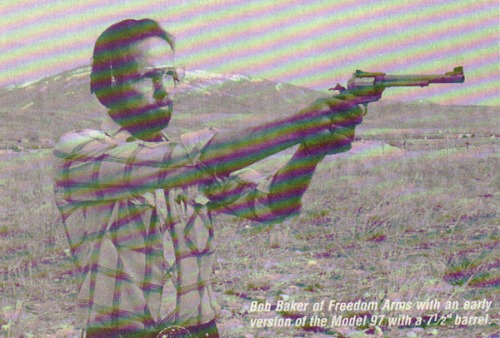
The holsters, or pouches, are available in two size holsters. The small one comfortably accommodated the Model 97 with the 2x Leupold pistol scope, but will handle scoped revolvers with up to 7.5″ barrels or scoped single shots with barrels up to 10″. The longer barrel holster handles up to a 10.5″ revolver or 15″ single shot.
Once the straps are adjusted to fit the owner, the rig can be carried comfortably all day and hides easily under an outer jacket or rain poncho for protection from the elements. I never encountered any inclement weather at the YO Ranch, but the scoped revolver rode in the nylon shoulder holster for three days in total comfort.
Freedom Arms did a great job in their downsizing effort. The end result is an outstanding combination of trail gun, hunting handgun, and cowboy “hogleg.” Although the hue and cry has already started about what would be the best next caliber for the Model 97, the .357 Magnum now being offered is arguably the best general purpose handgun caliber ever devised.
Skeeter Skelton once wrote an article about the one gun-caliber dilemma. He selected the .357 Mag., and while he chose a different manufacturer’s gun, it would be interesting to see what his selection might have been if the Model 97 had been available. Freedom’s new .357 certainly is a candidate for the one-gun man or woman.
Published: GUNS – September 1998
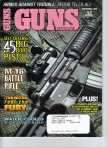

 We live in an age of labels. Worse still, most of these labels are assigned with political motives to achieve a calculated emotional effect. Shooters suffer as much or more than any other group from this 20th century phenomenon.
We live in an age of labels. Worse still, most of these labels are assigned with political motives to achieve a calculated emotional effect. Shooters suffer as much or more than any other group from this 20th century phenomenon.